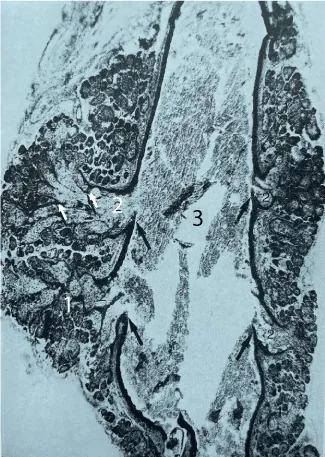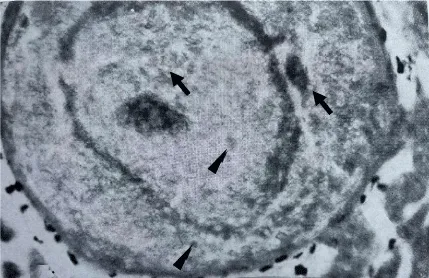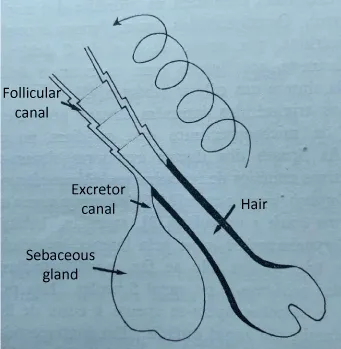Journal of Biology and Medicine
The helical movement of sebum
José Mesquita-Guimarães*
Cite this as
: Guimarães JM (2021) The helical movement of sebum. J Biol Med 5(1): 016-018. DOI: 10.17352/jbm.000026It is estimated that helical is the movement of planets in the solar system, the DNA format, the pathway of the excretory ducts of the eccrine sweat glands in the human epidermis, the evolution of our thoughts when they improve and even as banality, the movement of water in our washbasins towards the drain pipes.
And what happens with the movement of sebum of the sebaceous glands?
In lemurs
In 1962, W. Montagna verified that in some lemurs (primates from Madagascar), the path of the ducts of the sebaceous glands that are independent of the hairs is helical and appears colored black by melanin produced by melanocytes in the interior of the sebaceous glands [1].
In the rat sebaceous preputial glands
Of all the sebaceous glands, the rat sebaceous preputial glands, due to their size and accessibility, are particularly useful for research. These are two elongated, symmetrical glandular masses, located in the subcutaneous cellular tissue on either side of the penis or clitoris. Up to the third week of age, they are pyriform and pearly white in color. They later become flattened, yellowish-pink in color and increase markedly in volume until, between the seventh and tenth week, they reach 12 to 15 mm in length and 5 to 6 mm in width. The configuration is similar in both sexes, although adult males usually have larger glands and longer extraglandular excretory ducts [2].
The secretory units of the rat preputial sebaceous glands are tubuloacinous, formed by glandular acini with basal cells, in the beginning of differentiation, differentiated, completely differentiated and in disaggregation, similarly to what happens in the human skin sebaceous glands. In addition, the glands have a rich ductular network constituted by numerous secondary excretory canals of different caliber that converge in a single main excretory duct (Figure 1) [3].
The lining epithelium of the excretory duct is initially a simple squamous one and progressively stratifies as it approaches the main excretory duct. In this there are 6 to 8 layers of overlapping cells, the number reaching 15 layers near the opening of the duct in the preputial meatus [3].
The keratinization that occurs in the main excretory duct of this gland is of the soft type and the fine morphology of the cellular structures that compose it is identical to the epidermis and excretory ducts of the sebaceous glands in the man’s skin [3].
The chemical composition of the secretion product is very similar to human sebum [4] and the hormonal response to androgens, to estradiol and to orchidectomy is identical [2,3,5,6].
In the rat preputial sebaceous glands, spontaneous greenish fluorescence of medium intensity was observed in the acini, in the newly-formed sebum and in the sebum of the center of the main ducts, while on the periphery of these ducts the sebum showed yellow fluorescence. These results led the authors to suggest that the secretion is localized, initially, in the center of the lumen of the excretory ducts and then spreads to the periphery of the lumen [7]. Some of our morphological and cytochemical findings support this suggestion. In fact, we noticed a predominance of perinuclear granules and pycnotic nuclei of secreting cells in degeneration in the sebum in the center of the intraglandular portion of the secondary excretory ducts, while on the periphery the large crystalloid masses stand out, formations which represent a later stage of the evolution of perinuclear granules (Figure 2) [3]. On the other hand, the fact that in cross-sections we observe an oblique convergence of the secondary ducts into the main one, suggests that in the progression of the sebum there is a helical movement.
From our side, we can see that in the rat sebaceous preputial glands on the right side of the body, the movement of the sebum is levorotatory, whereas in those on the left side the movement is dextrorotatory, i. e., clockwise.
And in the human sebaceous glands?
The same is observed in the pilosebaceous follicles of human skin, where the sebaceous glands are usually joined to the hair follicles forming the classic pilosebaceous unit. The pilosebaceous follicles are a morphofunctional unit composed of sebaceous glands, a hair and a follicular canal. For example, the pilosebaceous follicles localized on the face and upper third of the trunk, where acne vulgaris occurs, are characterized by having developed sebaceous glands, one small hair and a long and wide follicular canal [8].
The hairs are made up of root plus shaft. The cuticular cells of the shaft are completely keratinized, arranged longitudinally and juxtaposed in the intra-follicular portion (Figure 3).
In human hairs, cuticular cells have a characteristic disposition, they are interwoven like roof tiles and show protrusions and recesses in the surface. The cuticles of the hairs and the corneal cells of the keratinized epithelium that lines the follicular canal are regularly juxtaposed in the respective protrusions and recesses (Figure 3).
The hair cuticle is made up of fully keratinized anucleated cells with hard keratin, which do not require keratin-hyaline granules nor membrane-coating granules. The hard and soft corneal cells are the same, but the hard ones do not peel off, they are permanent, solid and are removed by cutting. The soft ones peel off and are preceded by granulosa cells containing kerato-hyaline granules and membrane- coating granules [9].
The follicular canal is limited by a keratin stratified squamous epithelium that progressively stratifies in the distal direction. In the proximal portion, the corneal cells are scarce and easily peel off. In the most distal portion, up to 15 layers of intimately juxtaposed cells are counted.
In the follicular canal, the sebum does not move in any way, i. e., the sebum is not limited to being pushed by a secretion that is continually renewed. Although this is the case in the excretory ducts that immediately follow the sebaceous glands, where the peeling of the soft flat cells of the wall does not interfere with the movement of sebum, in the follicular canal the panorama is different. The sebum travels in a space limited by hard structures that are the wall of the follicular canal and the hair. This means that in the follicular canal the sebum movement becomes disciplined and the hair acts as a drain. Furthermore, the insertion of the excretory duct of the sebaceous glands in the follicular canal is oblique, the hair is convex, the canal is concave, the hair also has an oblique position in relation to the skin surface and, consequently, the movement of the sebum is helical (Figure 3).
I insist that, similarly to what happens with the helical movement of the sebum in the rat sebaceous preputial glands, in the pilosebaceous follicles of the human skin the movement of the sebum is levorotatory in the right half of the body and in the opposite direction, i. e., dextrorotatory in the left half.
In search for the truth (and wonder), I would be delighted if what I have just suggested was verified.
And why is the movement helical? I do not know.
- Montagna W (1962) The skin of lemurs. Ann N Y Acad Sci 102: 190-209. Link: https://bit.ly/3wzJIkW
- Beaver DL (1960) A re-evaluation of the preputial gland as a “dicrine” organ from the standpoint of its morphology, histochemistry and physiology. J Exp Zool 143: 153-173. Link: https://bit.ly/2ThHWa3
- Mesquita-Guimarães J (1974) Citologia da secreção holócrina. PhD final thesis, Tipografia da Sociedade de Papelaria Lda., Porto.
- Nicolaides N (1965) Skin lipids. II. Lipid class composition of samples from various species and anatomical sites. J Am Oil Chem Soc 42: 691-702. Link: https://bit.ly/3fMA5sq
- Sherins RJ, Bardin CW (1971) Preputial gland growth and protein synthesis in the androgen-insensitive male pseudohermaphroditic rat. Endocrinology 89: 835-841. Link: https://bit.ly/34eRIvL
- Mesquita-Guimarães J, Coimbra A (1981) The effect of sexual hormones on the lipid and proteinaceous secretion of the rat preputial sebaceous gland. Arch Dermatol Res 270: 325-331. Link: https://bit.ly/3uk74cQ
- Montagna W, Noback CR (1946) The histochemistry of the preputial gland of the rat. Anat Rec 96: 111-127. Link: https://bit.ly/2TkUTA1
- Kligman AM (1974) An overview of acne. J Invest Dermatol 62: 268-287. Link: https://bit.ly/3i4wbhF
- Ham AW (1969) Histology. In: 6ª Edition J D Lippincott Company. Philadelphia.
Article Alerts
Subscribe to our articles alerts and stay tuned.
 This work is licensed under a Creative Commons Attribution 4.0 International License.
This work is licensed under a Creative Commons Attribution 4.0 International License.




 Save to Mendeley
Save to Mendeley
